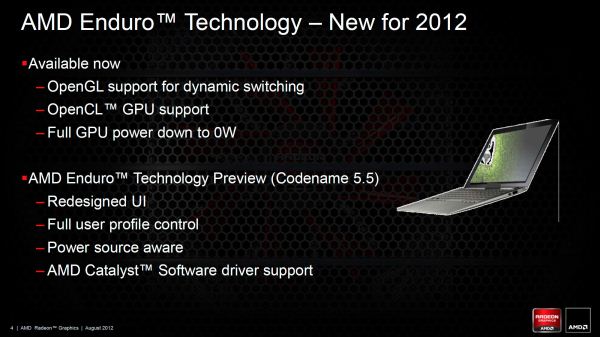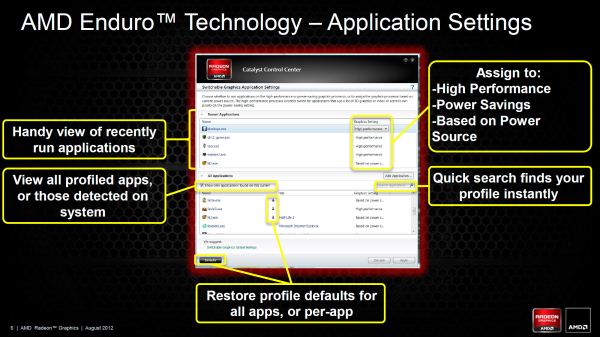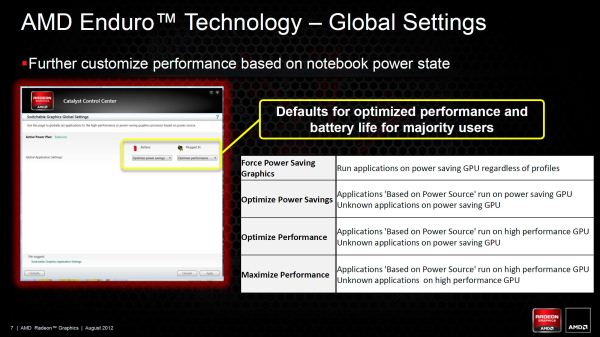AMD’s Enduro Switchable Graphics Levels Up
by Jarred Walton on September 6, 2012 3:00 AM ESTNew for Mid-2012: “Enduro 5.5” Enhancements
When AMD created the Enduro brand, they were really almost where we wanted them. They had dynamic switching with support for most of the latest games and applications, and when it worked properly it would be difficult to tell if you were using an NVIDIA or an AMD dGPU. The problem was when things didn’t work and you had to go into the drivers, and there were several problems. OpenGL support was totally out, many of the latest games were also missing default profiles (and sometimes wouldn’t let you properly specify the correct GPU), the UI was obtrusive and sometimes hard to use (particularly for power users), and the drivers were dictated by the laptop manufacturers and were usually months old at launch and never updated.
While the UI seems like a minor thing to fix—I would have thought one or two months to improve the UI would have been sufficient—at least prior to the forthcoming update it remained largely unchanged. The lack of AMD-provided driver updates was really the major issue, because everything else could potentially be fixed with new drivers and you would never know. The other areas like OpenGL/OpenCL and support for various games/applications should improve over time as well, provided you can get drivers. That brings us to the upcoming Enduro release, scheduled to come out sometime this month or next. Officially it’s still just Enduro, but to help differentiate between the previous Enduro release and the upcoming release we’ll sometimes refer to the new version as “Enduro 5.5”.
The biggest news with the latest iteration of Enduro is that AMD is planning to make universal reference drivers available for all the Enduro laptops. It’s not clear precisely what that means, but potentially any laptop with Dynamic Switchable Graphics or later (e.g. PX4.0 and later) would be supported by AMD’s “reference” drivers. That’s huge, and if AMD can deliver it will assuage most of our concerns with their hardware/software. Hopefully none of the OEMs get bent out of shape or refuse to allow support, which is a problem we've seen in the past. We should see the first public release in the next month or two, and then another release somewhere in the November/December timeframe.
Besides the availability of driver updates, the UI also receives a much needed overhaul, providing both regular and power users all the options they’re likely to need as far as control of graphics switching is concerned. Open up the switchable graphics options and the top section remains largely the same, but the bottom now allows you to see all application profiles (or just the profiles for detected applications). There’s also a quick search option that works both on executable name and application/game name (e.g. HL2.exe or Half-Life 2 will both find the profile for Half-Life 2). From either list (recently used apps up top, or all apps at the bottom), you can set the GPU profile.
Where previously there were two settings (three if you count “Not Assigned”), there are now three options. As before, “Power saving” sets an application to run on the integrated graphics while “High performance” sets an application to run on the discrete GPU. The new third option is “Based on power source”, which does precisely what you’d expect: plug the laptop in and the apps with this setting will run on the discrete GPU; switch to battery power and they’ll run on the integrated graphics. For many users, everything could default to “Based on power source” and they would be happy, but certainly there will be times where you’re running on battery power but still want to use the dGPU and the drivers give you that option. Should things get squirrelly, you can also reset applications individually or globally to their default settings. It’s worth noting that the power state aware setting is something that NVIDIA currently does not implement, requiring manual intervention if you wish to override your normal settings—though how often people are using apps that require the dGPU while on battery power is something we could debate.
Besides the individual application profiles, AMD is also adding a new area to their drivers: Switchable Graphics Global Settings. This is something you could sort of get before with some laptops, but previously it involved changing from Dynamic Switchable Graphics to manual switching (i.e. switching based on power source) and then forcing the laptop into High Performance or Power Saving mode if you wanted to be low power while plugged in or high power while unplugged. That was clunky and at least in the case of the Sony VAIO C we tested it caused flickering similar to the old switchable graphics, with the dGPU drivers getting unloaded and iGPU drivers getting loaded (or vice versa), with some work behind the scenes copying context from one GPU to the other. It worked but it wasn’t elegant; perhaps more importantly, Microsoft doesn’t want anyone doing this with Windows 8 and thus new laptops won’t be able to get a Windows 8 sticker if they use this method of switching (which basically means no new laptops will do this). To make up for the loss of this functionality (which some people still prefer), AMD has added a new global settings section.
Unlike the individual application profiles, the global settings gives you four options each for Battery and Plugged In. The top two options are similar in most cases and will generally run most applications on the iGPU, and the same goes for the bottom two modes where you’ll run most apps on the dGPU. The difference is that “Force Power Saving GPU” will run all applications (regardless of what the custom profile says) on the iGPU, essentially disabling the dGPU completely. “Optimize Power Savings” in contrast will run all unknown or “Based on power source” applications on the iGPU while respecting the application profiles where they exist. “Optimize Performance” is sort of the reverse of that, running all “Based on power source” applications on the dGPU while leaving unknown applications on the iGPU. Finally, the “Maximize Performance” option runs all unknown and “Based on power source” applications on the dGPU—but applications specifically set to use the iGPU will continue to do so.
The reason for that last discrepancy (e.g. why you can’t simply run everything on the dGPU and forget about the iGPU) is that certain tools have to run on the iGPU. Intel’s drivers are one example—loading those up on the dGPU would cause problems. Intel’s WiDi is the only other I could find on my particular Clevo notebook. We were told that some of the laptop utilities like an overlay showing percentage of brightness, volume, etc. may also need to run on the iGPU. Besides the few applications that have to run on the iGPU, any applications that are set to Power Saving will continue to use the iGPU—and this makes sense as there are a lot of applications that can be set to run on iGPU/dGPU that have no need of higher performance GPU options (several anti-virus utilities come to mind, where they're starting to create a 3D context for their UI). The net result is that other than a few specific applications where the profile will exist and be locked to the iGPU, with no option to change to dGPU, everything else that uses higher function graphics can be customized to run on a specific GPU, but if you set something to iGPU presumably you want it to always run there—otherwise you would use the “Based on power source” setting.
A full set of screenshots from all the driver screens is available in the gallery below if you’re interested.
One final topic worth discussing is Windows 8. Certainly there are owners of existing laptops with switchable graphics that are wondering if they can upgrade to Windows 8 and what will happen. We’ll have to see how this actually plays out, but it sounds like the earlier versions of PowerXpress (3.0 and earlier) will probably get support with one driver bundled with Windows 8, and that may be it—but there’s always the possibility for the laptop OEMs to release their own updates, or for AMD to roll out additional drivers for older laptops. The potential for PowerXpress 4.0 and later laptops to get regular driver updates (for Windows Vista/7/8) is there, but until we actually start seeing public driver releases AMD hasn’t fully committed to supporting all of those laptops.



















200 Comments
View All Comments
Vozier - Thursday, September 6, 2012 - link
Again great work Jarred, your help is like a boat in the middle of the ocean for many here.Maybe you can forward the GPU usage %s to AMD, who knows if they are aware of this.
some other games you might test are:
Crysis 2
Witcher 1 and 2
Skyrim
BF3 (specially multiplayer)
What everybody here wants is that GPU can be assigned, fixed, forced, you name it to work 99% at any setting or game we want it to, to forget about power saving. Maybe thats easier to get faster than a working "60fps minimum performance" solution.
and again thanks! I will definetely buy from anadtech in the future, just for this.
regards
Voz
Zoomer - Friday, September 7, 2012 - link
That's not going to happen. The frames are transferred over PCIe, and that's a limited shared resource. Uncapping it would just take away bandwidth and increase latency for the other unimportant stuff, you know, like textures and geometry.arcticjoe - Saturday, September 8, 2012 - link
Nvidia can do it, why cant AMD? Otherwise its a little unfair for consumers who pay ridiculous money for a top of the range card that also has a major with a design flaw severely limiting its performance.Woodchuck2000 - Thursday, September 6, 2012 - link
Any chance of Anandtech investigating this issue? Reading through the support forums, it doesn't look like user complaints have made a difference. I suspect that if a site like Anandtech publishes some hard numbers, we'll actually see a fix for these issues.JarredWalton - Thursday, September 6, 2012 - link
There have been no driver updates since launch for Clevo 7970M users, so of course there haven't been any fixes. AMD is basically saying step one is to get support for Enduro laptops into their regular Catalyst driver updates, and once that's done end users should see fixes at the same time desktop drivers get fixes. This has not yet happened, but it's supposed to happen by the end of the year.arcticjoe - Thursday, September 6, 2012 - link
There may not be any official releases for Clevo, but you can install most mobility releases on a EM series laptop, including the latest 9.0 leak (Catalyst 12.8). They all work in games, but the issue with GPU under-utilization remains the same in all releases so far.Also, 7970m was released in March - not being able to use it properly for the majority of its lifecycle as the top mobile AMD card is really pathetic.
JarredWalton - Thursday, September 6, 2012 - link
I don't know if others are having better luck, but at least when I tried installing the non-Enduro Catalyst drivers on the P170EM it did nothing good. I think I got the updated Catalyst control panel but still running old drivers. Hacking drivers to get them to install is not the same thing as having proper driver support. Enduro has a lot of lower level stuff going on in the drivers that regular discrete-only cards don't have to consider. If they work at all, I'm surprised, but I wouldn't expect 100% optimal performance from them.TokamakH3 - Thursday, September 6, 2012 - link
You've nailed AMD's major problem on the head with this statement. No official drivers for the 7970M since launch, what 4 months ago? With a whole portion of the owners practically screaming that the GPU is garbage in the latest games? The only 7970M owners who are happy are those that can completely disable Enduro via the BIOS. That's absurd.krumme - Thursday, September 6, 2012 - link
For the past 3 years amd have had the best, most efficient, arcitechture for for mobile market, and even still for this generation something that can compete with kepler.How on earth they can bring themselves in a situation not having a product similar to optimus is one of the biggest management failures. Is simply unforgiving. What were they thinking on?
Instead of focusing on fx crossfire with absolutely no economic importance, they have let this obvious technology take 2 years later than it needed to. With amd insight, they should be 1 year ahead of nv here. Pathetic management, and it was obvious 2 years ago.
AMD strategic decisions is always some technical extreme long term roads. Like APU could save their mobile business. Man, its sad to watch. Engineering thinking when it fails.
There have been a lot of people leaving AMD lately, and lots of tears for that. Well, they might be technically good, but business people they were not.
RR have a lot to do at AMD to clean up this mess.
JarredWalton - Thursday, September 6, 2012 - link
"With amd insight, they should be 1 year ahead of nv here."Wait, exactly why would anyone expect AMD to have better insight than NVIDIA? Or Intel? Isn't this the same company that underdelivered on Bulldozer? And K9 basically never happened because it was so far off of what was needed? AMD has the potential to compete and even exceed NVIDIA and Intel, but while they have done so on occasion there's no reason to say they should consistently be ahead.